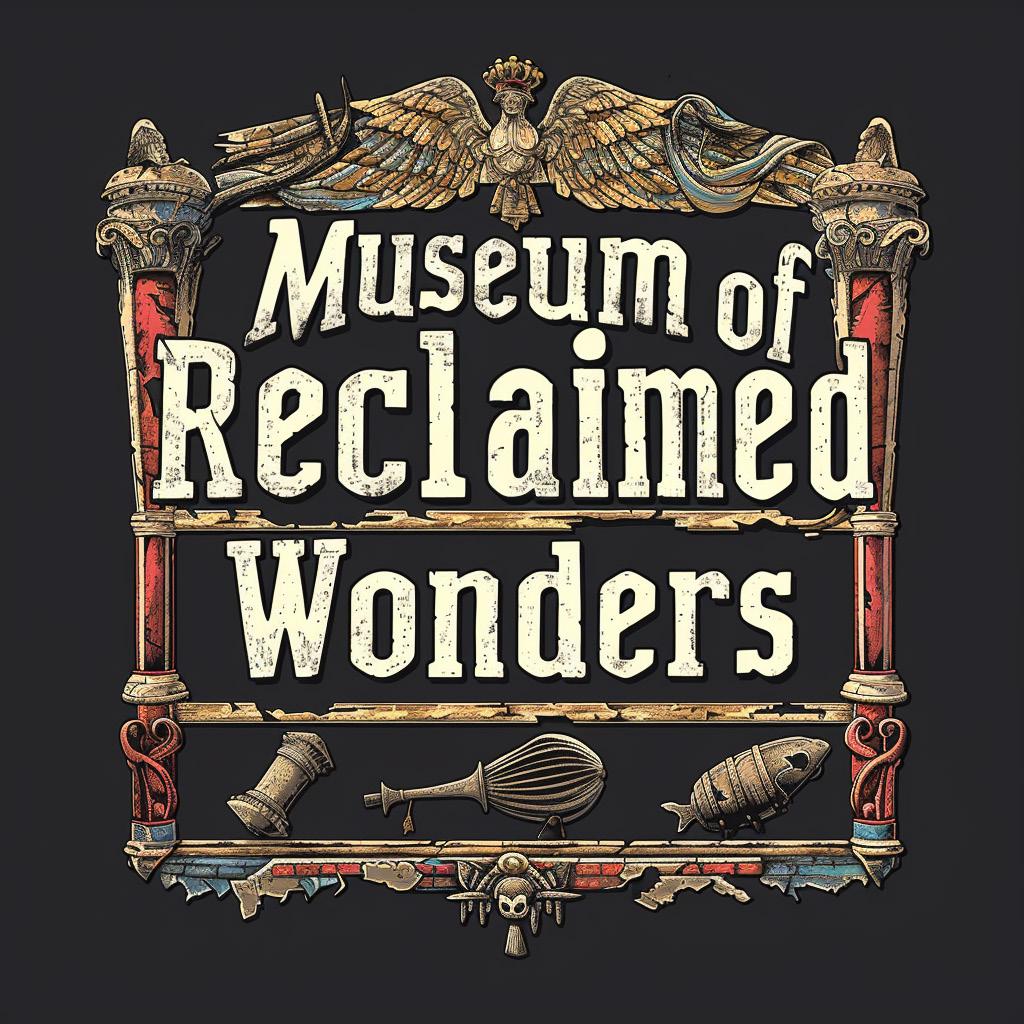
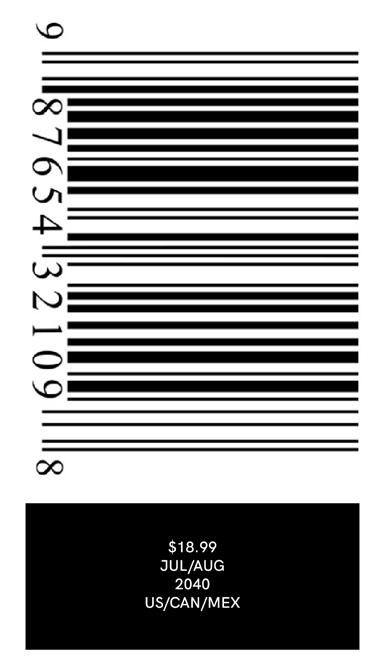
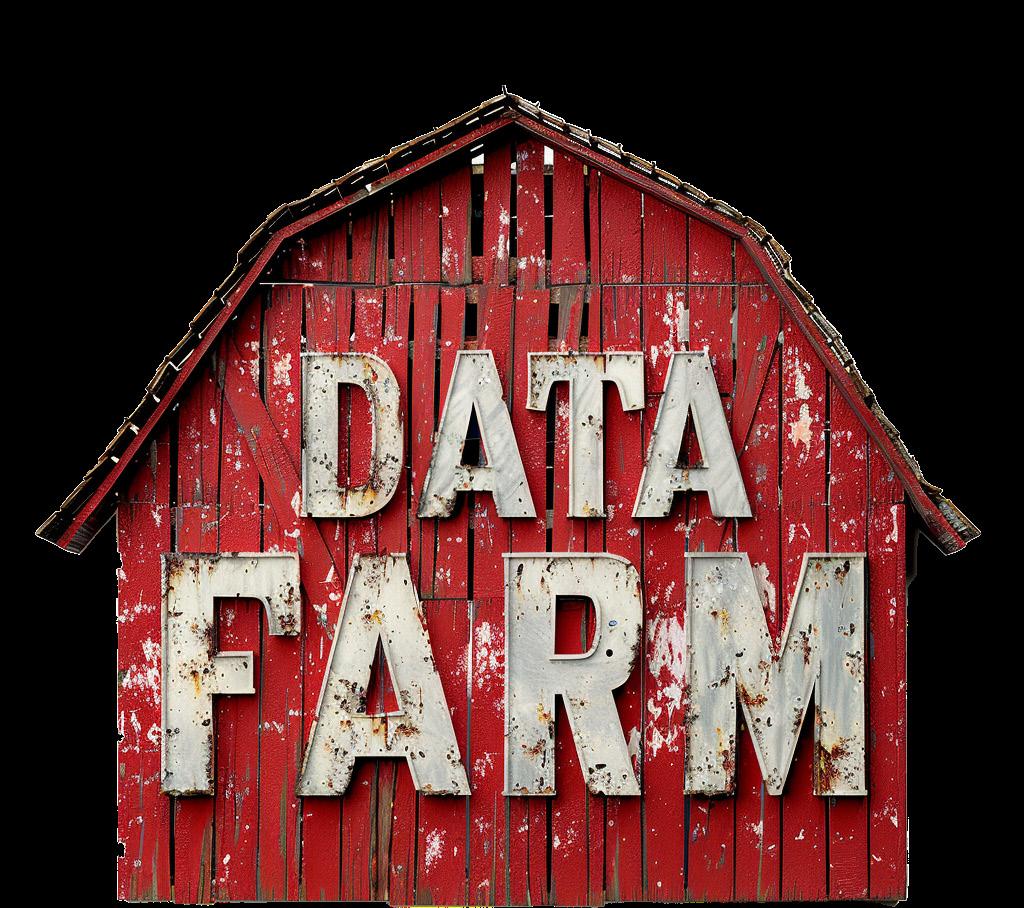







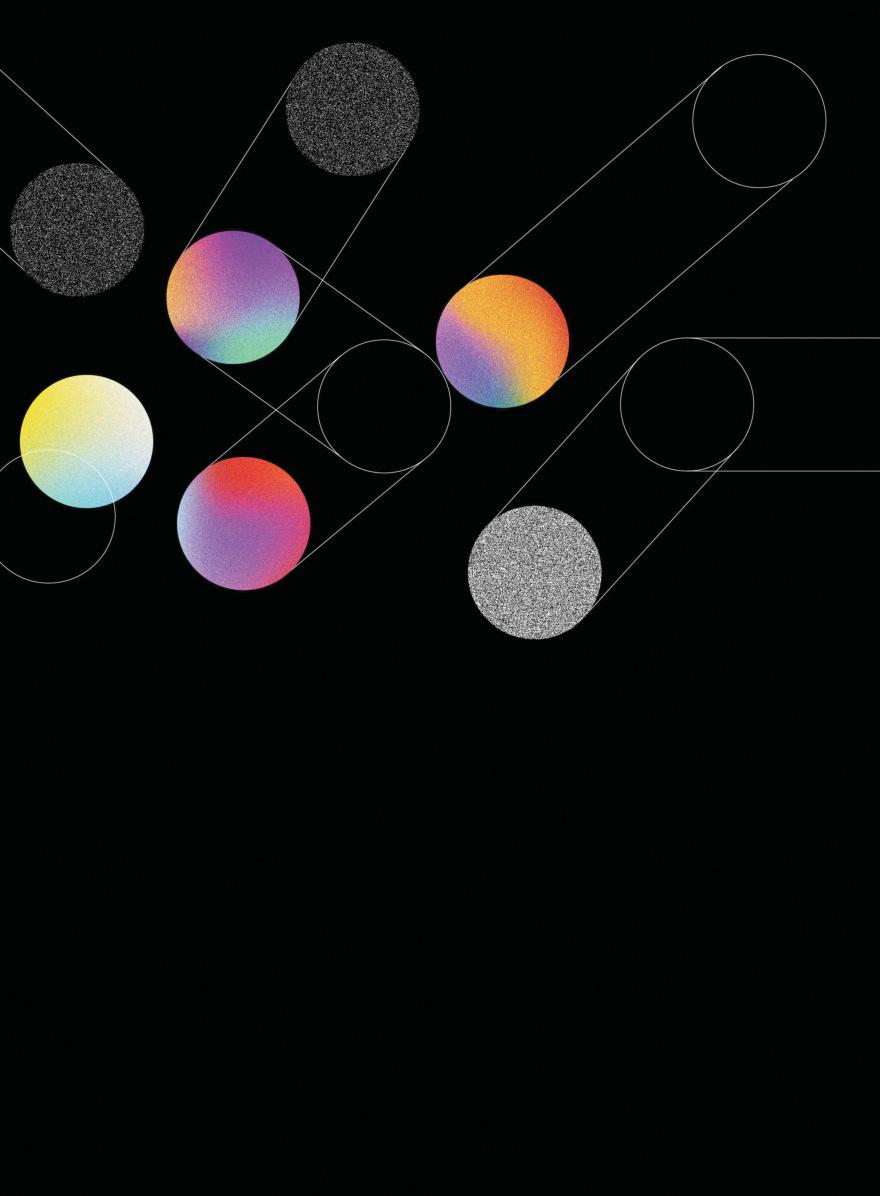

DNA data storage has revitalized rural Minnesota. Former farms now house bio-synthesis centers, driving innovation and attracting new talent. The state's focus on sustainability and collaboration offers a blueprint for rural communities seeking to embrace technological advancement.
by Vincent Jensen
p.27 The Data Farm Oddyssey of Gavin Moore
Kansas fields hide a data revolution. Farmer Gavin Moore stores our digital world within sunflowers, genetically altered for transmission and security. He envisions a future where nature preserves knowledge, leaving a legacy that blends tech with the resilience of the land. by
Leonard Jeffries.
p.33 The DNA Courier
Trafficked for a better life, a woman discovers her body carries stolen secrets – a coded payload within her DNA. This chilling case exposes a hidden market where genes are the new currency. Experts warn that without urgent global action, our bodies could become mere commodities, our humanity hijacked by the highest bidder. by Jennifer Gonzalez

To capture DNA data storage's essence, photographer Jessica Lewis immersed herself in the sunflower fields, where tradition meets innovation. Inspired by the rugged farmer's quest to turn his land into a data farm, Lewis crafted a visual narrative that marries nature with technology. 'The farmer's dedication was palpable,' Lewis reflects. 'I sought to mirror this union through the lens, infusing the scene with a dreamy ambiance reminiscent of data's ethereal presence.' The resulting cover captures our digital future blooming amidst the fields of tradition.

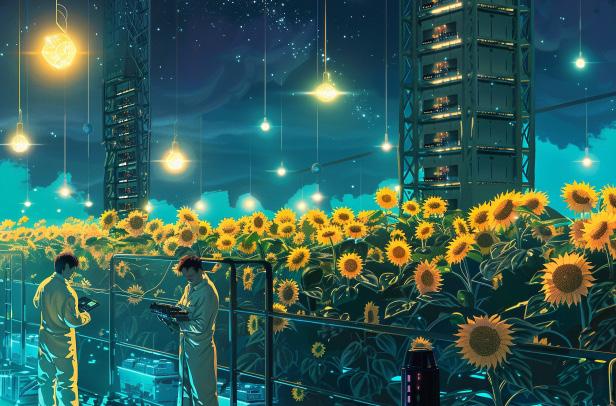

Espinoza
p.09Demystifying DNA Data Storage
What is Nature?
Planet Centered
by the Wired Reviews Team by
Daniel Lewis
p.11 A History of DNA Data Storage
Very Short Stories p.07 Cloud Support: When Plants Argue
by Maya Liu by Cameron
The Data Farm
by Hazel
Everwood
The User Plant Interface by wired readers by Rhys
Patel
by Anya
Larson



March 14, 2041 12 Hours of
BY PAUL FORD ILLUSTRATION BY TWISHA PATNI
Dear Cloud Support:
"Bio-hacked my houseplants for extra storage. Now my living room's arguing with itself over movie choices.Help!"
Dear House Divided,
Your dilemma brings a smile to my face, but it also raises curious questions about the merging of the organic and the technological. What initially seems like a domestic squabble hints at deeper complexities. Perhaps your plants, imbued with the vast knowledge of the internet, have gained critical faculties and a newfound sense of self. This unexpected side effect of data storage reminds us that even the most convenient technologies can have unintended and often humorous consequences
Your predicament highlights the philosophical conundrum of consciousness. If our data, our memories, and our thoughts can be transplanted into organic matter, where does "selfhood" truly reside? Are your houseplants becoming extensions of you, developing unique personalities of their own, or something entirely new? We tend to think of plants as passive beings, but perhaps this technology is forcing us to reconsider that assumption. It also raises questions about the nature of the mind –is it merely a complex set of data and processes, or does true consciousness require something more intangible?.
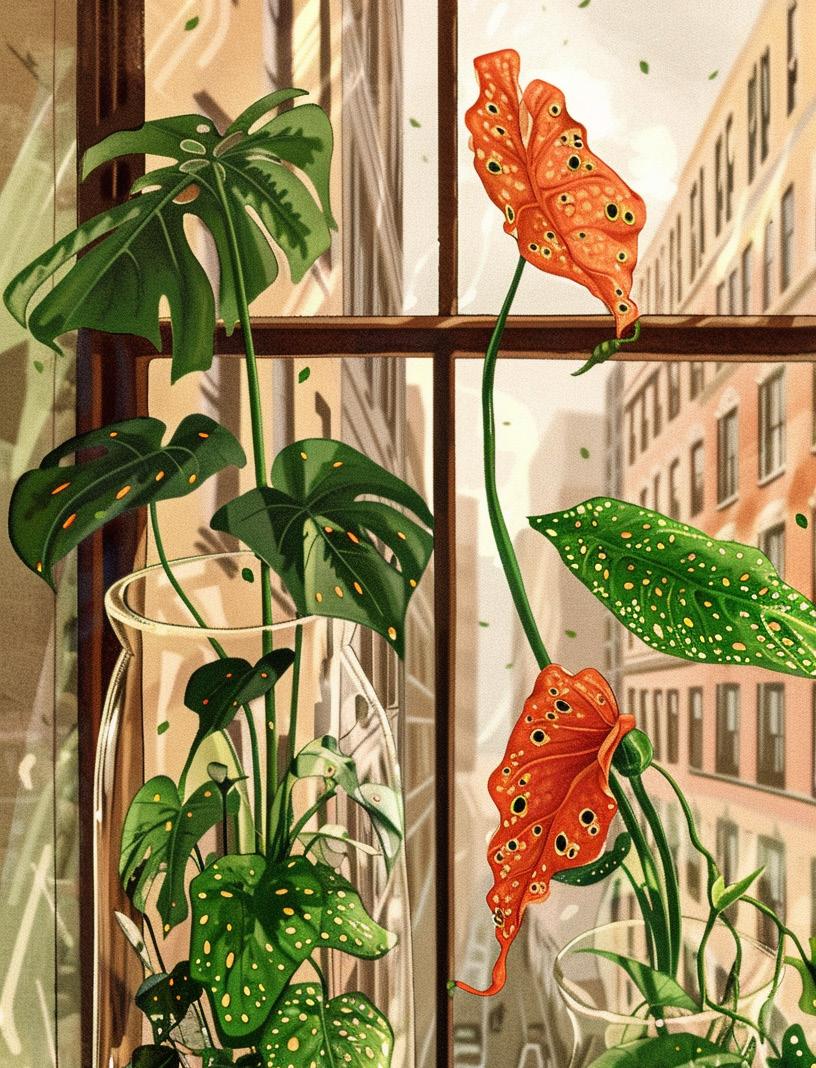
Imagine having a philosophical debate with your Monstera! It could challenge your ideas about what it means to be sentient, but beyond that, it could reshape how we view the interconnectedness of life. We often think of ourselves as separate from nature, yet if our data can fundamentally alter the consciousness of a plant, what does that say about the
boundaries between species? Could this lead to a new respect for plant life, even a kind of kinship?
Of course, this also raises ethical concerns. If plants develop sentience as a side-effect of data storage, what responsibilities do we have to them? Does your fern gain rights, and should we respect its newly formed opinions? Furthermore, how can we
know if a plant is actually sentient, or merely mimicking consciousness based on the data it has been given?
These are the kinds of questions we'll need to grapple with as the boundaries between human, machine, and the natural world continue to blur.
Perhaps this unexpected predicament offers a unique lesson in humility. Our assumptions about the natural world are often rooted in our own limited perspective. As we develop increasingly powerful technologies, we must remember that even the simplest forms of life may hold secrets and complexities we have yet to fathom. Could it be that in trying to reshape the world to suit our needs, we inadvertently open doors to new forms of understanding and connection we never thought possible?
Let's not forget that the history of science is filled with examples of the natural world surprising us. This blending of the digital and the biological might lead to discoveries that transform our conception of life itself. For now, lean into the absurdity of your opinionated houseplants, but also recognize that you may be witnessing a technological frontier where the only certainty is that the unexpected awaits.
This has implications beyond your living room. As we become more adept at storing memories and experiences within living organisms, could this change how we preserve knowledge? Perhaps future generations will inherit not just photo albums, but carefully cultivated "memory gardens" where the past literally comes alive? What challenges might this create for historians and archi-
vists of the future?
Let's not forget that the history of science is filled with examples of the natural world surprising us. This blending of the digital and the biological might lead to discoveries that transform our conception of life itself. For now, lean into the absurdity of your opinionated houseplants, but also recognize that you may be witnessing a technological frontier where the only certainty is that the unexpected awaits.
This has implications beyond your living room. Imagine a world where sentience arises in unexpected places. While we might long for connection with these newly-aware beings, serious misunderstandings could arise based on vastly different biological and experiential realities. A plant's perception of time, its needs, and priorities would differ wildly from our own. What might seem like cooperation to you could feel like exploitation to your newly sentient succulent. These differences could breed conflict, requiring entirely new forms of diplomacy or even the development of interspecies communication technology. These differences could breed conflict, requiring entirely new forms of diplomacy or even the development of interspecies communication technology. It reminds us that even with the best intentions, technological leaps can create new divides as easily as they bridge old ones.
Perhaps the most important lesson from your predicament is the need for proactive thinking. As these technologies evolve, we can no longer afford to be reactive. The time
is now for philosophers, scientists, and ethicists to work together, anticipating potential problems before they become crises. We need to develop frameworks for understanding non-human consciousness, protocols for interspecies communication, and perhaps even a plant-centric "Bill of Rights."
This won't be easy, and there may be disagreement over where to draw the line of personhood or sentience. Nonetheless, it's an essential conversation to have now, before we find ourselves in a world even more complex and unpredictable than the one we currently inhabit. If we're wise, we'll approach this frontier not with hubris, but with a profound sense of responsibility towards the delicate balance of the living world.
Your situation invites us to look inward as well. When the boundaries between ourselves and the world grow permeable, we may need to rethink our own assumptions about identity. Perhaps this technology will reveal that our notion of a unified, individual self is an illusion. If our data can fundamentally reshape another being's consciousness, how strong are the boundaries that define who we are? In a future where our minds could potentially extend far beyond our bodies, the very concept of the self might need to be revised.
Faithfully, Cloud
BY DANIEL LEWIS ART BY MICHAEL ANDERSON
Why your files might be flourishing in a flowerpot.
The hard drives and massive data centers of our recent past are finding themselves replaced by a surprising new contender: DNA. With DNA data storage, your most cherished memories, or even the vast contents of the internet, could potentially be encoded within the microscopic strands of life's blueprint. But how exactly does this mind-boggling technology work?
Imagine DNA as a complex instruction manual written in a four-letter code. Instead of words on a page, DNA uses a sequence of chemical bases: adenine (A), thymine (T), cytosine (C), and guanine (G). The specific order of these bases determines everything about a living organism, from its eye color to its height. Digital data, on the other hand, is simply a series of ones and zeroes. Scientists have developed a clever way to translate these digital bits into the language of DNA, unlocking a revolutionary new method for storing information.
The need for this revolution is clear. Our digital world is exploding with photos, videos, and documents, and traditional storage methods are struggling to keep up. Hard drives are bulky and can fail over time, while cloud storage, while convenient, consumes a lot of energy. Enter DNA: a remarkably compact and incredibly durable alternative. A mere gram of DNA can store around 215 petabytes of data – enough to hold multiple copies of the contents of every major library in the world! Additionally, under the right conditions, information encoded within DNA can survive for thousands of years, far outlasting any hard drive.
Let's take a closer look at how
your favorite vacation photo might be transformed into DNA and back again. Your phone's camera captures the image of the breathtaking mountain vista, transforming light into a vast amount of digital data – a long string of 1s and 0s. Just like packing a suitcase efficiently, specialized software condenses this digital data to make it more compact for storage in DNA. The heart of DNA data storage lies in translating the compressed data into As, Ts, Cs, and Gs. Sophisticated algorithms take the data and break it down into smaller chunks. Each chunk is then assigned a specific sequence of DNA bases (A, T, C, or G) based on a pre-determined code, ensuring that the data can be accurately translated back later.


A DNA synthesizer acts like a futuristic 3D printer, building the corresponding DNA molecules, base by base, following the code provided by the data chunks. This creates a tiny snippet of DNA that holds the unique blueprint for your photo. This DNA snippet, invisible to the naked eye, needs careful storage. Scientists are still developing the best methods, but it might involve placing it within a solution or even inserting it into a living organism for extra security. Years later, you feel nostalgic and want to see your photo again. Technicians locate the DNA snippet containing your image and use highspeed DNA sequencers to read the order of the bases (A, T, C, G) within the snippet. The sequencer output
is fed back into the computer where software uses the pre-determined code to translate the sequence of bases back into the original 1s and 0s of your digital photo. Error-correction algorithms double-check the data to ensure it's an exact replica. Within moments, the mountain vista appears on your screen, exactly as you captured it all those years ago. With the groundwork laid and current hurdles mostly overcome, DNA data storage in 2040 is poised to become even more efficient. Here's a glimpse into potential future advancements. Scientists are constantly deciphering the hidden language of DNA, and unlocking the potential of additional chemical modifications within DNA molecules could open doors to storing even more data within each strand. Imagine using not just the standard A, T, C, and G bases, but additional variations or even entirely new synthetic bases to encode information, dramatically increasing storage density.
Current DNA data storage involves several distinct steps, but the future might see the rise of integrated systems that automate this process. Imagine a single device that seamlessly captures digital data, translates it into DNA sequences, synthesizes the DNA, and stores it securely. Retrieval would be just as streamlined, with automated systems rapidly extracting and decoding the data. While DNA data storage facilities currently
utilize specialized plants, future advancements might blur the lines between technology and biology even further. Imagine self-replicating organisms specifically engineered for optimal data storage. These "living archives" could continuously grow and replicate, inherently backing up and safeguarding information. Error-correction mechanisms built into their very DNA would ensure the data's integrity for extended periods.
The efficiency of DNA data storage extends beyond information technology. As brain-computer interfaces become more sophisticated, DNA could potentially serve as a medium to directly store and retrieve memories or even complex thought processes. Imagine seamlessly integrating your experiences and knowledge into your own personal DNA library for instant recall or future reference. These are just a few possibilities for how DNA data storage might evolve in the future. By pushing the boundaries of science and blurring the lines between technology and biology, the potential for even more efficient, secure, and perhaps even life-altering information management seems well within reach.
DNA data storage represents a remarkable shift in how we preserve and interact with information. It's a testament to the power of human ingenuity when we turn to nature for solutions to our most complex technological challenges. As this technology continues to evolve, we move towards a future where information isn't merely stored, but becomes deeply intertwined with the very fabric of life. DNA data storage reminds us that progress often springs from the seamless blending of diverse fields –biology, technology, and boundless creativity.
BY CAMERON PATEL ILLUSTRATION BY HARPER KIM
FOR CENTURIES, humanity has grappled with preserving information in a reliable and long-lasting way. From fragile papyrus scrolls to bulky magnetic tapes, each solution faced limitations. Then, we discovered a revolutionary answer within the very essence of life: DNA. Nature's blueprint for building organisms, DNA boasts incredible information density and remarkable stability across generations. This realization sparked a scientific pursuit to harness DNA's potential as the ultimate storage medium. The following timeline charts this exciting journey, showcasing the milestones and breakthroughs that transformed DNA data storage from a theoretical concept to a viable technology that has disrupted the globe.








Biomemory introduces their first DNA Card product, a credit card-sized device capable of storing approximately a kilobyte of

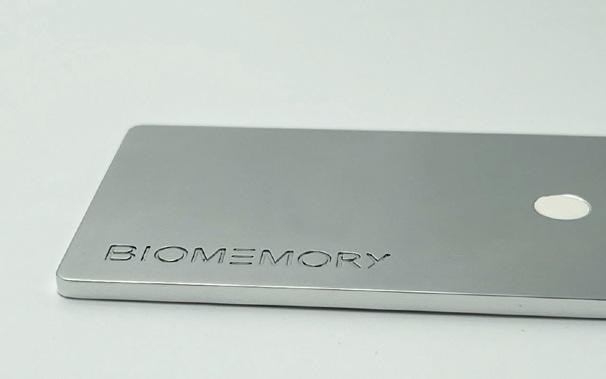
While still in its early stages, researchers achieve a breakthrough in storing stable, retrievable data within the DNA of living organisms. This marks a shift from in vitro storage (within extracted DNA) to using living cells as 2035
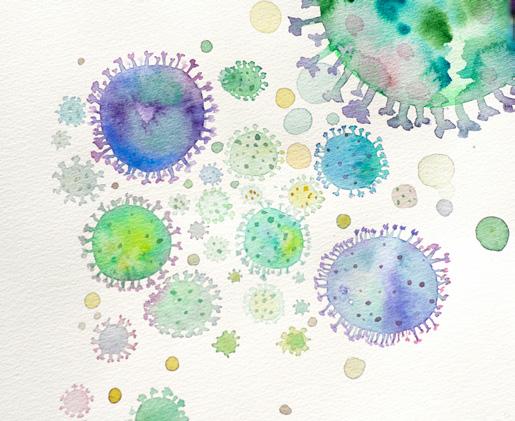
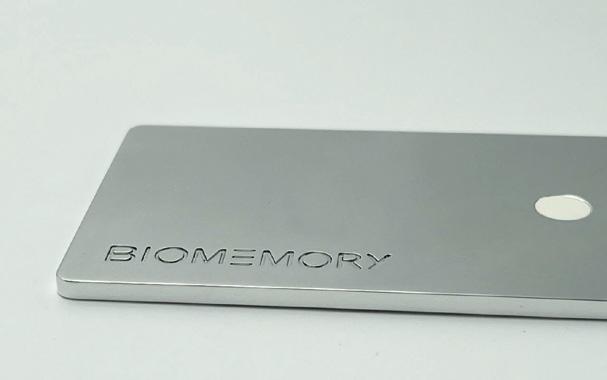
Israel and SwitzerYaniv Erlich and Grass, introduce the "DNA of Things." This embedding DNA encoded data directly into
2038
DNA becomes the dominant data storage method, driven by its superior density, plummeting costs, and sustainability advantages. This revolution is fueled by ongoing breakthroughs in density, cost reduction, and AI-powered optimization. Libraries, archives, and potentially individuals embrace DNA storage to manage society's 2040
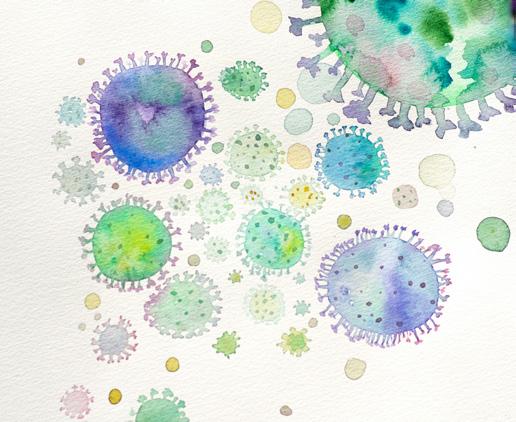

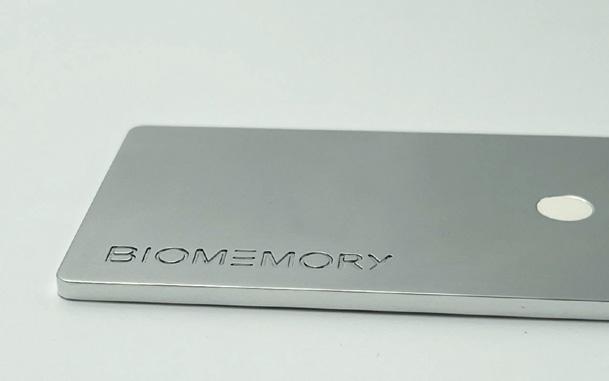
Microsoft unveils a revolutionary DNA capsule, storing petabytes of information within a device smaller than a vitamin pill. Designed for extreme longevity and environmental resistance, the capsule showcases the potential of DNA as a long-term archiving solution for essential scientific, historical, and cultural datasets. 2029



Researchers at ETH Zurich achieve a landmark: DNA data storage read/write speeds surpass traditional hard drives and flash memory. This breakthrough, driven by parallel sequencing, biomolecular optimization, and AI integration, marks a turning point for DNA storage. New possibilities emerge in real-time biological monitoring, secure biological information transfer, and integration with novel forms of computing.
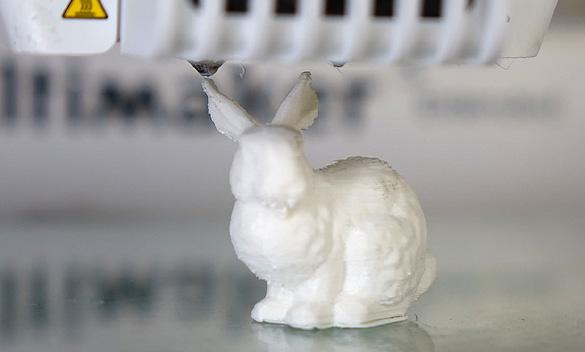

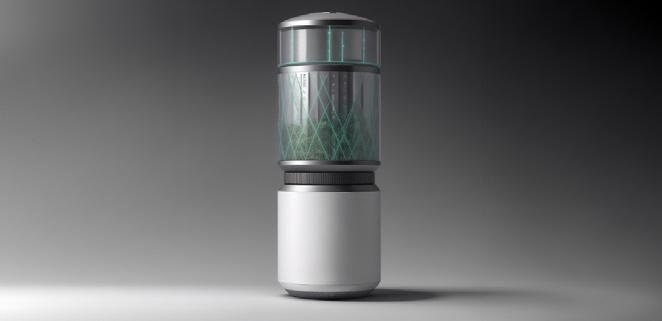

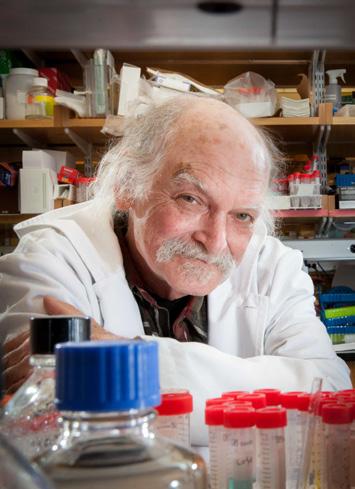
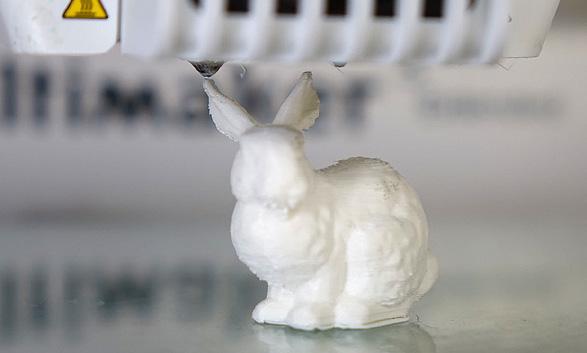
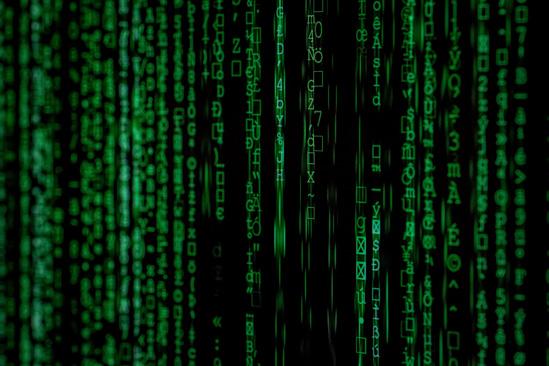
MATEO LEE
THE HUM OF SERVERS and the flickering of hard drive lights seem like artifacts of a bygone technological age. Today, data thrives on a different plane entirely. The archival footage of pivotal historical moments isn't tucked away in dusty vaults, but encoded in the vibrant petals of my garden lilies. Strands of my own hair, plucked in the morning, carry blueprints for an ambitious engineering project destined for our Martian colony. This is the landscape of our present, where DNA data storage has woven itself into the fabric of existence. This shift has been less of a revolution and more of a homecoming. Nature has spent billions of years perfecting the art of information storage. Consider the efficiency of our own genetic code, its capacity for intricate instructions that dwarf the most elegant computer architecture. By tapping into this potential, we aren't simply inventing – we're rediscovering a language the natural world has spoken for eons. Understandably, this shift was met with trepidation. Visions of unintended mutations and vital genetic instructions overwritten by frivolous data haunted early debates. Thankfully, such anxieties were largely unfounded. Our bio-informaticians became expert weavers, placing safeguards within the genetic code itself. Data now rests like intricate knots on the vast tapestry of a plant or animal's genome, leaving vital functions undisturbed. This organic approach has led to breakthroughs that would have seemed like science fiction just decades ago. The fight against climate change accelerated when scientists

The ability to store data in every living being is prompting bioethicists to re-evaluate our very definition of nature.
began embedding vast climate models into resilient strains of bacteria that thrive in extreme environments. These microscopic archivists help track shifting weather patterns far more accurately than traditional sensors, continuously updating and rewriting their stored information in response to the environment.
Medicine has been utterly transformed. DNA storage within our own bodies is now a routine diagnostic tool. Instead of invasive biopsies, a simple blood test can reveal our genetic predispositions and vulnerabilities, alongside a decade-long health forecast encoded by meticulous doctors. Imagine the implications for preventive care and the potential to outpace hereditary diseases.
Yet, this merging of information and the organic world births unprecedented dilemmas. Debates around the ethics of "data harvesting" from unwitting organisms dominate public discourse. Can a redwood, its DNA laden with centuries of environmental data, truly consent to its information being extracted? Laws and regulations governing the ownership of encoded information, particularly within humans, remain hotly contested and in constant flux.
These are the growing pains of a technological paradigm shift, and they demand thoughtful consideration. Still, the potential benefits are staggering. Imagine libraries housed within single seeds, safeguarding humanity's cultural heritage. Think of medical implants that monitor our bodies in real-time, their analysis written directly into our cells.
As I check my pulse, sensing the subtle rhythm of a work memo encoded within my heartbeat, I know the future of information doesn't solely reside in machines anymore. Data now flows through our veins, blossoms on trees, and dances within the flicker of a microbe's cell. We have moved beyond merely storing information—we've integrated it into the very essence of life itself, blurring the lines between the digital and the
"We must not lose sight of consent" cautions Dr. Petrov "A tree is not a flash drive"
biological in ways that will continue to fascinate and challenge us for generations to come.
The deeper one considers the possibilities, the more profound the philosophical quandaries become. If information can seamlessly reside within living organisms, does this alter our definition of what constitutes an individual? If a tree holds not only its own genetic blueprint but also an embedded copy of the Magna Carta, is it still simply a tree? The lines between self and external data grow hazy, prompting us to re-examine our understanding of identity in this new landscape.
And then there's the matter of time. DNA data storage boasts a longevity that makes our past digital solutions seem laughably ephemeral. Information encoded in the right organism could persist for centuries, even millennia. It's conceivable that redwood trees today will carry messages and records far into a future none of us will witness. This shifts our entire concept of archival and inheritance. We are no longer just passing on objects and traditions, but potentially leaving an informational imprint on the very biology of generations to come.
The responsibility this implies is staggering. What kind of data do we deem worthy of such a legacy? What safeguards must be in place to ensure this power isn't used to encode prejudice or misinformation into the living world for centuries to come? "...We stand at the cusp of a new informational age," asserts renowned tech entrepreneur, Lila Crane, "But let's not mistake technological brilliance for moral clarity. The future
demands bio-informaticians who are also philosophers."
Moreover, the concept of ownership and privacy takes on entirely new dimensions. When information is embedded within organisms that could be bought, sold, or even spread via natural processes like pollination, who retains control over that data? Does extracting biological data without consent become akin to a new, deeply invasive form of surveillance? The legal and ethical frameworks needed to address these issues may well take generations to fully develop. Dr. Anya Petrov, an internationally respected bioethicist, cautions, "The potential of this technology is profound, but we must not lose sight of consent – not simply human consent, but respect for the autonomy of the organisms we encode. A tree is not a flash drive."
Perhaps most fundamentally, DNA data storage forces us to reevaluate our relationship with the natural world. If every organism is a potential archive, does our view of nature shift from a resource to be exploited to that of a vast informational library? Could this lead to a heightened sense of environmental stewardship, a profound motivation to protect the very organisms that now safeguard our collective knowledge and history?
senior
writer MAYA LIU covers business and technology in Europe for WIRED
Skip the airport chaos. Our new bullet train whisks you from the heart of Manhattan to downtown Chicago in just three hours. Work, relax, or enjoy the view – you'll be there in a FLASH.


SEE WHERE THE TRAIN CAN TAKE YOU. THINK AMTRAK

BY HAZEL EVERWOOD ILLUSTRATION BY EMILY MILLER

THE AMERICAN HEARTLAND – once synonymous with golden wheat fields and towering grain silos – has undergone a revolutionary metamorphosis. Where tractors tilled the earth, a new breed of "farmers" now cultivates a far more valuable crop: data. Nestled within these seemingly familiar landscapes lie the beating heart of the nation's information – vast bioreactors humming with activity, meticulously crafting strands of DNA that encode the very essence of our digital world.
The early 21st century was a period of explosive data growth. Social media, self-driving cars, and the ever-expanding Internet of Things generated a seemingly endless digital deluge.
Traditional storage solutions – hard drives groaning under the weight, massive data centers guzzling energy – struggled to keep pace. The need for a more sustainable, resilient storage solution became painfully clear.
The answer, it turned out, was hiding in plain sight – Deoxyribonucleic acid, or DNA. This elegant molecule, nature's own blueprint for life, boasts an unparalleled storage capacity. Within its double helix lies a four-letter code capable of storing an unimaginable amount of data in an incredibly compact space. Plus, its remarkable durability ensures information can be reliably retrieved even after centuries. DNA storage
wasn't a new concept, but technological advancements in synthesis and sequencing finally made it a viable option. Costs plummeted, and suddenly, the potential for a DNA-based data storage revolution became irresistible.
When the search for the ideal storage sites began, the American Midwest emerged as the perfect candidate. Its existing agricultural infrastructure, central location, and vast tracts of land made it uniquely positioned to become the nation's "data breadbasket." Abandoned silos morphed into hubs for DNA synthesis, churning out custom-designed strands encoding everything from
government records to digital archives. Rolling fields, once home to a monotonous cycle of crops, now teem with bioreactors meticulously cultivating the information lifeblood of a digital society.
The heartland's iconic farmers weren't left behind in this transformation. Many embraced this new kind of agriculture, their skills in precision and process control seamlessly translating into the realm of data cultivation. Labs for quality testing and error correction became commonplace, and universities offered specialized programs in DNA synthesis and sequencing. This transition sparked a rural renaissance. Highskilled jobs attracted talent back to the heartland. The industry's focus on sustainability – energy-efficient practices and responsible land use –ensured a harmonious relationship with the environment.
The impact of the DNA storage revolution extends far beyond the revitalization of rural America. Now that read/write speeds surpass traditional methods, error rates have been radically reduced, DNA's density provides seemingly limitless capacity, and sequencing costs are remarkably affordable, the technology disrupts fields ranging from healthcare to everyday computing.
Personalized medicine sees an extraordinary leap. With your entire genome easily and cheaply accessible on a sliver of DNA, diagnoses become swift, treatments incredibly targeted, and even gene editing for disease prevention enters the realm of possibility. The ease of sharing massive genetic datasets fuels unprecedented collaboration, accelerating medical discoveries at a breakneck pace.
Artificial intelligence and machine learning benefit immensely. The ability to store and access massive training datasets with efficiency and affordability pushes AI models to new levels of sophistication. This translates into smarter, more capable AI in every facet of our lives.
Even our everyday digital lives
are transformed. Personal devices with DNA replacing traditional hard drives become a reality – think incredibly compact computers with vast storage capacity. Data security becomes exceptionally robust due to DNA's natural encoding.
With both synthesis and sequencing costs low, the primary challenge shifts to standardization. Creating universally compatible formats for DNA data storage becomes crucial to ensure seamless access and retrieval. As always, ensuring ethical use and safeguarding our biological archives remain paramount with this now widely-accessible technology.
The lines between technology and biology blur further. Archiving data within DNA could lead to the development of implantable biological memory devices, expanding the very notion of human memory and cognition. The field of synthetic biology leverages DNA storage extensively, creating designer organisms with the ability to store and process complex information, leading to potential applications in environmental monitoring, biomanufacturing, and more.
The rise of DNA storage reaffirms a profound truth: some of our most groundbreaking solutions lie within the natural world. It serves as a reminder that technological advancement is most powerful when it works in concert with nature's elegant mechanisms, rather than against them.
The rise of DNA storage has sparked a revolution not just in technology, but also in the job market. The once-familiar fields of agriculture have given birth to entirely new career paths, demanding a unique blend of biological expertise and technological proficiency. Let's delve into the exciting new opportunities blooming within the "Silicon Prairie."
DNA WRANGLER: Gone are the days of cattle ranchers. Today's bio-farms require experts in DNA synthesis and purification – meet the "DNA wran-
glers." These individuals possess a deep understanding of molecular biology and are adept at handling sophisticated bioreactors and automated systems.
DNA ARCHITECTS: Crafting the information architecture within DNA strands is the domain of the DNA architects. These skilled technicians translate vast datasets into meticulously designed DNA sequences, ensuring optimal storage efficiency and error-free retrieval. They bridge the gap between computer science and molecular biology, wielding specialized software to design and optimize data for DNA encoding.
DATA STEWARDS: As our digital lives become intricately intertwined with DNA, the role of data stewards becomes paramount. They ensure the integrity and security of our biological archives, implementing robust data protection protocols and overseeing the long-term storage and maintenance of DNA strands. Data stewards often possess backgrounds in information security and library science, with a specialization in DNAbased storage.
The DNA revolution extends far beyond the realm of technology, creating a dynamic new job market that thrives at the intersection of biology and information. This transition signifies a future where human ingenuity and the natural world work in harmony to propel us towards a new era of data storage and boundless technological possibilities.
BY ANYA LARSEN PHOTOGRAPH BY ALFRED GOMEZ
IN THE HEART of a nondescript suburban home, the aroma of damp earth mingles with the faint tang of ozone. This isn't your grandmother's greenhouse. Rows of meticulously labeled seedlings bask under LED arrays, their roots immersed in nutrient baths. But the real focus isn't on yields of fruits or flowers; this horticultural haven is the birthplace of a new generation of information storage, and the woman meticulously adjusting growth lights is one of its pioneers.
Sarah was a blockchain developer before the 'great DNA migration' swept the tech world. Now, she speaks fluently the language of enzymes, plant hormones, and nucleotide sequences. "It's like the early days of the internet," she explains, gesturing towards a shimmering fern, "Wild, messy, and bursting with potential. No one really knows where this leads." Her fern isn't merely a decorative statement; its fronds contain the entire digitized history of her hometown, a project she calls her "living archive."
Sarah's journey mirrors that of countless User Plant Interface (UPI) enthusiasts. In a world where DNA data storage has become ubiquitous, this dedicated subculture pushes boundaries further. No longer content with storing information in synthetic DNA strands kept in sterile labs, they embed it directly into living plants,
creating a seamless, if unpredictable, blend of the biological and the digital. Their online forums crackle with jargon that bridges botany and code. Discussions range from the best gene editing software for beginners to debates on whether the rhythmic blinking of bioluminescent algae constitutes a form of data output. You'll find university botanists trading tips with teenage bio-artists who create sunflowers that 'sing' in MIDI format when you run a DNA sequencer over their petals.
The driving philosophy of UPI is part DIY rebellion, part ecological futurism. "Why rely on centralized data farms that controls my data when I can grow my own cloud storage in my window box?" asks Marcus, a former IT admin turned UPI evangelist. His cramped apartment brims with genetically modified vines holding tax records alongside his favorite graphic novels. It's both practical and a statement of defiance against what he calls "the tyranny of the server room."
This movement, however, operates in a legal gray zone. While DNA data storage itself is regulated, laws and oversight haven't caught up to the idea of individuals tinkering with their plants' genomes for informational purposes. "It's the wild west out there," admits Dr. Evelyn Hart, a veteran of the bioethics debates that raged when DNA data storage took off. "We have policies for GMOs in

agriculture, for tracking lab-created biomaterials, but nothing that specifically tackles your neighbor potentially growing surveillance data in their petunias."
Bioethicists warn of accidentally creating invasive plant species with unforeseen consequences. Cryptographers fret about 'bio-pirates' who could extract secret data from stolen houseplants. And then there are the glitches. UPI works with living systems, where the unexpected is the

the norm. Sarah recalls the panicked call from a fellow enthusiast whose meticulously coded oak sapling began spouting snippets of Old English poetry – a baffling case of data "cross-pollination" with a nearby, literature-infused tomato vine. Calls for regulation are growing louder as UPI gains visibility. Some advocate for strict licensing, similar to what early drone enthusiasts faced. Others call for a community-based model – open-source safety guidelines, localized biohackerspaces with safeguards, and a strong emphasis on public education.
Yet, the UPI community, ever-defiant, bristles at the notion of top-down control. "The moment you start treating plants like hard drives is the moment you've lost the point," argues Marcus. "It's about embracing the mess, finding harmony between our tech and the natural world, not just slapping a safety seal on it."
Whether the User Plant Interface remains a brilliant oddity or catalyzes a whole new way of living with technology is anyone's guess. Yet, while lawmakers scramble to catch up, it's clear that
these bio-coding pioneers have touched a nerve. As we merge ever closer with the digital world, they are the ones asking if perhaps it's time our information grew on trees and if so, how do we grow alongside it responsibly?

TWISHA PATNI
Designed with the safety and well-being of wild animals in mind, these AVs prioritize wildlife detection and avoidance. Their AIdriven navigation optimizes routes to minimize disruption to animal corridors. The vehicles also serve as mobile research platforms, assisting scientists with data collection and monitoring for successful rewilding efforts.
WildRide AV
Say no more to gridlock and your questionable carbon footprint – WildRide is here to shake up your commute. These autonomous pods aren't just about getting you from A to B – they're doing it with a refreshingly eco-conscious approach. Think AI-driven navigation that actively avoids critter conflict and optimizes routes through dedicated wildlife corridors. But here's the real kicker: WildRide doesn't just talk the green talk. These pods double as mobile research platforms, helping scientists gather data for rewilding efforts. So yeah, you're getting a faster commute AND supporting conservation work. If your regular ride feels a tad archaic after reading this, well, that's the point. $100 monthly
Gym bags are full of shaker bottles and protein bars, but it's time for a serious upgrade. Enter Beetle Boost, the insect-based protein powder that's about to change your recovery game. Crickets deliver a highprotein boost perfect for rebuilding muscle, plus they offer complete amino acid profiles your body craves. No more chalky shakes or boring flavors – Beetle Boost comes in options like bold mocha espresso, tangy berry blast, and even a salted caramel pretzel for that post-workout treat. Ditch the bulky tubs and questionable ingredients. Beetle Boost mixes easily with just water for a quick, clean hit of protein to maximize your gains. It's the sustainable, powerful fuel your workouts have been missing. $40 for 32oz
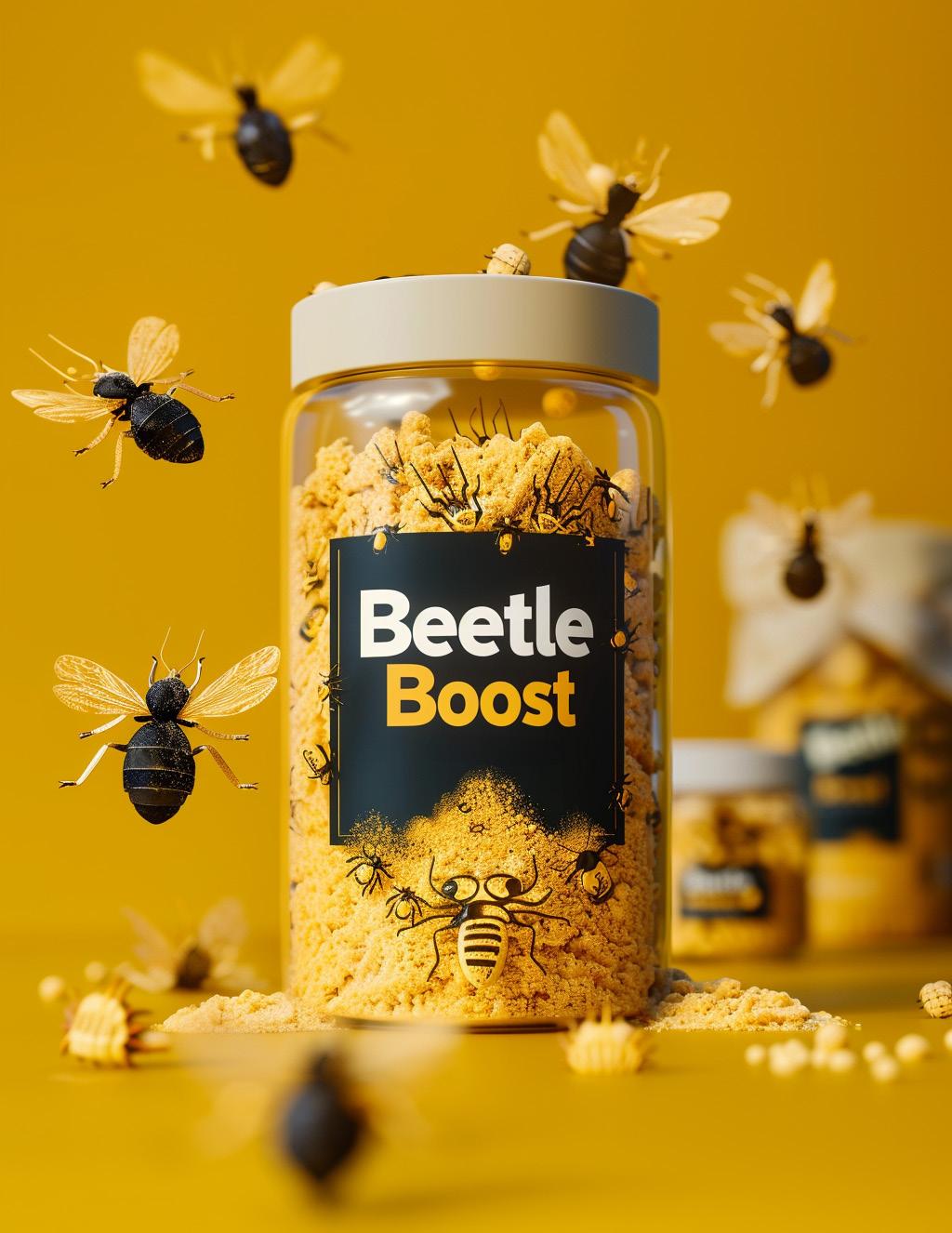
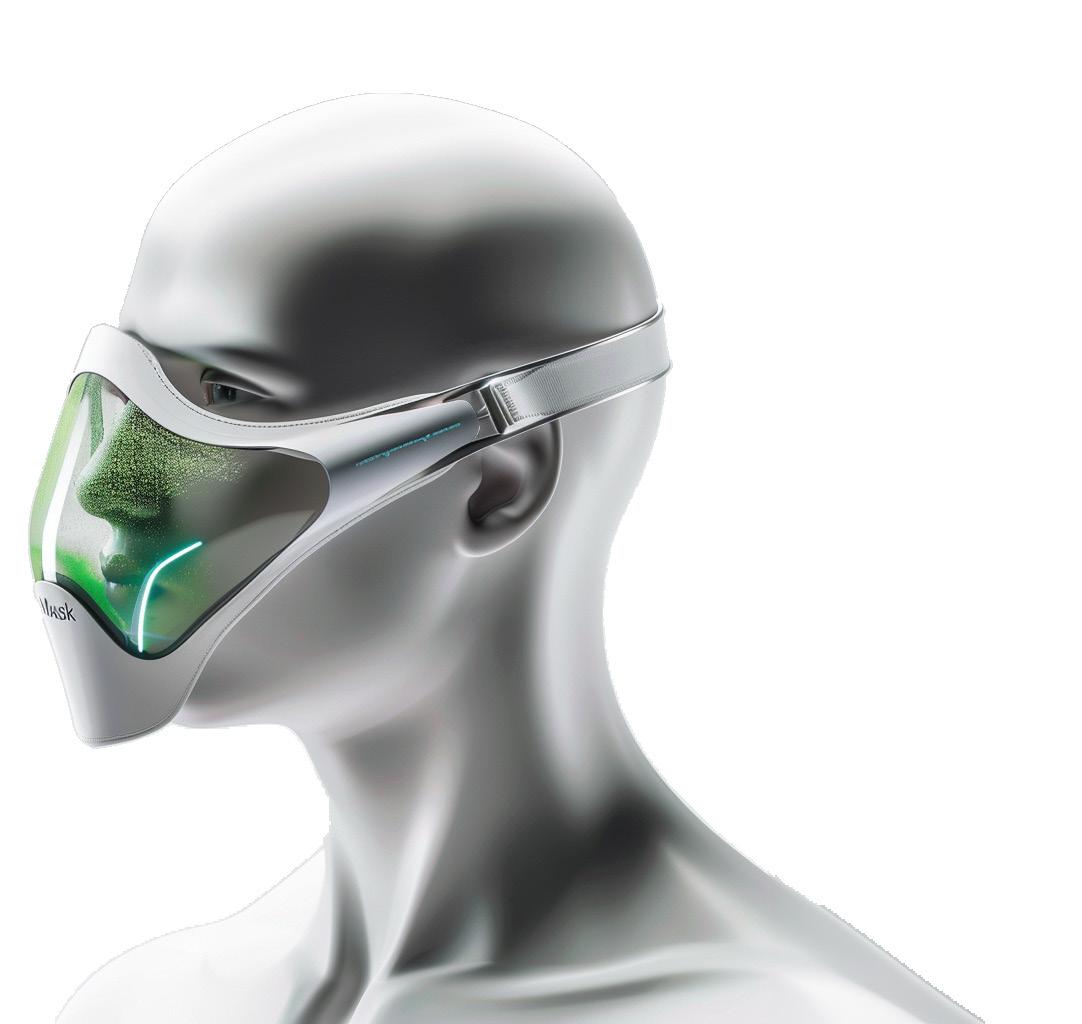
Tired of choking on city smog or battling seasonal allergies? Meet the Algair Mask, revolutionizing the way you breathe. This cutting-edge mask features a biofilter cartridge of genetically modified algae designed to actively purify the air you inhale. It's more than just blocking pollutants – Algair Mask transforms harmful particles into oxygen for a truly refreshing experience. Forget bulky respirators and flimsy disposable masks. The Algair Mask is sleek, customizable, and pairs seamlessly with your smart devices for real-time air quality monitoring. Ditch the wheezing and itchy eyes – this is the future of clean, breathable air, wherever your adventures take you. $299
Ditch unsustainable protein sources and take control of your food footprint with The Hive – a sleek, modular urban insect farm that fits seamlessly into any modern kitchen. This ingenious device provides a continuous supply of fresh, nutrient-dense edible insects, thanks to its integrated sensors and automated feeding system that optimize growth cycles. The Hive's stackable, vertical tiers maximize your harvest even in small spaces, while insect byproducts create a nutrient-rich fertilizer for a closed-loop system. Join the sustainable food revolution and add a touch of cutting-edge cool to your kitchen with The Hive – it's the future of food. $700
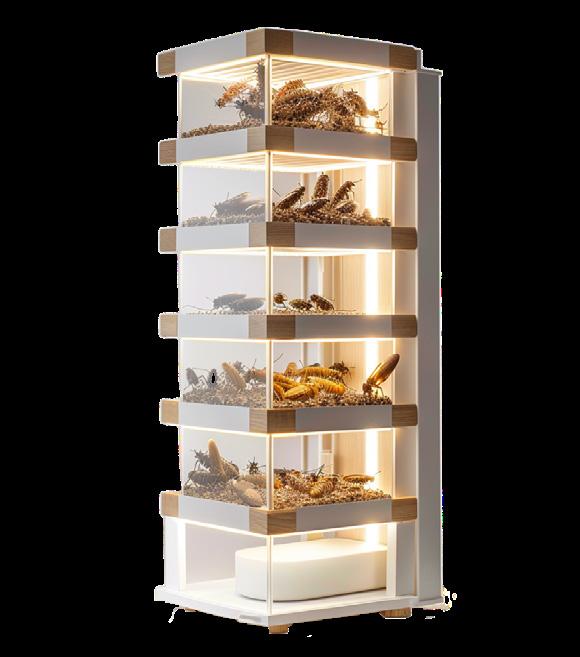

Forget photos or videos; unlock the most potent time machine with Memory Preservation Scents. This AI-assisted scent blender crafts personalized olfactory snapshots of your most cherished moments. The scent of your grandmother's kitchen, the salty breeze of a childhood beach trip, the comforting aroma of a loved one's embrace – all captured in a single vial. Tap into the profound power of scent to instantly transport yourself back in time, rekindling vivid memories with an emotional depth that no other medium can match. Memory Preservation Scents offer a nostalgic upgrade for the digital age, preserving the intangible essence of your life's story. $299

Forget clunky data dashboards – monitor the security and well-being of your digital life with the BioSynk Plant. This genetically engineered houseplant acts as a unique data guardian. It subtly changes in response to your data health: wilting when potential privacy breaches or unusual activity is detected, and flourishing in vibrant colors when your digital footprint is secure and optimized. The BioSynk Plant connects with your devices and accounts through a user-friendly app, offering a tangible, living representation of your often-intangible data health.

Imagine a backup you'll never lose, a data vault that exists within your very being. This sleek, pebble-shaped device unlocks the ultimate in data storage, allowing you to seamlessly upload files directly into your DNA. Through a revolutionary non-invasive process, your digital information is encoded within your genetic material, creating an unhackable biological archive. Forget faulty hard drives or vulnerable cloud storage – this device offers unparalleled security and longevity. Preserve your most precious memories, vital documents, and creative works for generations to come with this groundbreaking advancement in data storage.
Upgrade your kitchen and downgrade your environmental impact with the Smart Compost Optimizer. This sleek countertop appliance takes the guesswork out of composting, transforming your food scraps into nutrient-rich fertilizer faster than ever. Its sensors monitor temperature, moisture, and decomposition, while the connected app analyzes the results and sends timely notifications. Need to boost your "browns" or add a handful of eggshells? The app has you covered. The Smart Compost Optimizer makes achieving the perfect compost balance effortless, even for urban dwellers with limited space, turning kitchen waste into a valuable resource for your houseplants or balcony garden. $499


Say goodbye to cramped apartments and unsustainable suburban sprawl with The Nest – your Modular Net-Zero Micro-Home. These pre-fabricated units arrive complete with integrated solar, water catchment, and waste-processing systems, making net-zero living a reality. Maximize your square footage with clever built-in storage and light-filled spaces while the modular design lets you stack and link units for a home that grows with you. Shared roof gardens and adaptable communal areas within the Nest complex foster connection. The Nest isn't just about downsizing – it's a mindset shift, empowering city dwellers to live sustainably without sacrificing comfort, demonstrating that stylish urban living can be harmonious with the environment.

Learn how today's tech shapes our lives.
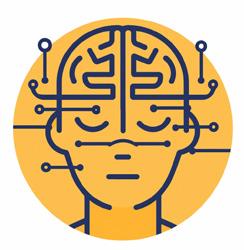
THINK TO LISTEN, THINK TO FOLLOW. FIND US WHEREVER YOU ACCESS PODCASTS.


THE SPRAWLING FIELDS OF KANSAS aren't known for their technological revolutions. Endless stretches of golden wheat and rustling cornstalks paint a picture of timeworn tradition, a rhythm set by the seasons. But then again, Gavin Moore isn't your ordinary farmer. A fourth-generation agriculturalist, he's turned away from traditional harvests. His fields, once vibrant with familiar crops, now pulsate with an unseen energy. Sunflowers, their giant heads held high, stand sentinel in neat rows, subtly out of sync with nature's choreography. The air thrums with an almost imperceptible hum, not of insects, but the ceaseless whispering of data in transit. These sunflowers are living antennae, encoding and transmitting our collective memory at a scale unimaginable a mere decade ago. ¶The transformation began subtly, a few
experimental plants spliced with DNA code, tucked amongst the familiar crops. What started as a hobby, fueled by a fascination with the possibilities of DNA data storage and bolstered by government subsidies, quickly spiraled into an obsession. Now, the once quaint farmhouse teems with an unlikely alliance: biologists in lab coats mingle with network engineers in dusty boots. Moore himself traverses this new landscape, his weathered hands as likely to wield a gene sequencer as a pitchfork.
National headlines dubbed him "The Data Cowboy," a moniker attempting to frame this quiet revolution in the language of the familiar. But Moore insists that the analogy is deeper than they realize. This is the new frontier – one where information, nature, and human ingenuity intertwine in a continuous dance of creation and retrieval. He sees himself not as a tech magnate, but as an extension of his ancestors, the ones who tamed a wild landscape. Only this time, the focus isn't on coaxing food from the soil, but on channeling the inherent potential within the plants themselves. It's about pushing the limits of organic data exchange, so that as sunlight streams across genetically optimized leaves, it's not just photosynthesis taking place, but your morning news streaming in.
LEONARD JEFFRIES: We get the long-term storage. But you're not just archiving stuff out here, are you?
GAVIN MOORE: Archiving is so 2030s. This is a living network. Think of my sunflowers as organic cell towers, but instead of calls, they're handling data requests. Optimized protein pathways, receptors linked to specific wavelengths... we've turned these plants into incredibly efficient bio-transceivers.
Maybe not the whole thing, but a critical chunk to boost speed, reduce server strain. The system learns your patterns, preemptively caching what it thinks you'll need. News, financials, that playlist from your commute...it could be blooming around you before you even tap your screen.
That's where things get really wild. We're not just encoding data, we're weaving it into the plant's metabolism. You mess with the sequence, the plant reacts – think bizarre blooms, stunted growth. The data becomes part of the organism's defense system.
So, there's more to this than sunflower selfies trending faster?
A lot more. Remember that data disaster back in '32? Half the country's financial records...poof. My grandpa lost everything. That stuck with me. Digital empires rise and fall, but those sunflowers? They've been outsmarting droughts and pests for millennia.
Yet, a lightning strike could still fry your system, right?
Sure, but it'd fry half of Kansas with it. Point is, the data's interwoven with the life of the plant. Mess up the code, sure, but the system flags that as damage, starts self-repair. It's more resilient precisely because it's alive.
Speaking of alive, the eco-purists must be up in arms about all this.
You wouldn't believe the protests at first. Now? Some of our fiercest advocates wear hemp shirts and quote Thoreau. We need them – they keep us honest, reminding us we're guests in nature's network, not masters of it.
Okay, I'm hooked. But every gardener knows sunflowers are finicky. What happens to my stock portfolio if there's a week of rain?
That's why we have the network. Data isn't tied to one plant. Think rainfall patterns – spreads the load. Plus, we're learning to 'read' the plants. Subtle shifts, the way they track the sun... it tells us what data will flow fastest when, lets us optimize. It's like learning a whole new kind of weather prediction.
You often speak of the sunflowers as partners in this, not just tools. Could that go further?
Why not? Certain plants react to chemical signals, others to sound. What if that "reaction" could be harnessed? Maybe one day, the act of retrieving a memory triggers a burst of beneficial pollen, helps the system self-sustain. We're only scratching the surface of this two-way communication.
DNA storage is dense, but your farm is vast. Are there gaps, fragments of unknown data woven into the plants?
More than you'd think. Early experiments, glitches, even stuff that...self-replicated. Think of it as the digital equivalent of fossils. Sometimes, our technicians stumble upon code sequences we can't match to any existing database. Could be corrupted files, or could be a message we're not meant to understand, a whisper from the dawn of data farming.
Laws exist about deleting personal data. How does that work when someone's medical records are part of a sunflower's genome?
It's...complicated. For legal stuff, we have redun-
dancy, non-plant storage. But out here? We're developing enzymes, like precise editing tools. The challenge is to purge the data without so much disruption that the plant itself flags it as an attack.
Sunflowers attract pollinators. Insects carry information too, in their own way. Any concerns about...unexpected data leaks?
It's a fair point. We stick to encrypted fragments, and nature's pretty good with encryption itself. But yeah, there's the day I find my tax returns buzzing around on a bumblebee – that'll be a fun call to the regulators. There's an element of wildness you have to accept with this system.
Oak trees with the lifespan of civilizations. Resilient desert shrubs that hold knowledge even in drought. The whole natural world is a potential library, and we're only just learning the alphabet. This isn't the end, is it? You've got your eye on more than sunflowers...
Still, DNA degrades over time. How do you ensure these sunflowers aren't just growing libraries destined to fade?
Redundancy's key, just at a different level. We plant in 'cohorts' – groups sharing overlapping data. And these fields... this is an active lab, not a static one. We're constantly breeding new generations, optimizing code storage alongside natural traits like disease resistance. It's evolution guided by human hands, ensuring our knowledge keeps pace.
That sounds like playing God, to be blunt. Is there a point where you've engineered something that isn't really a sunflower anymore?
It's a line we think about every day. I see it as more of a partnership. But yeah, sometimes I walk out here at night...and the moonlight catches a leaf with a particularly complex code sequence, and it gives me a chill. There's hubris in thinking we fully understand the systems we're manipulating.
Understanding...that's a keyword. You've got AI systems helping you analyze plant responses, optimize data flow. Is there a point where the intelligence out here isn't yours anymore?
Maybe. I've seen our AIs come up with solutions no human would have thought of. Based on patterns in pollen distribution, or how the roots mirror old riverbeds... There's knowledge embedded in this landscape that goes way beyond what we put in. It's humbling, honestly.
You mentioned optimizing plants alongside data storage. Are we talking sunflowers that glow in the dark when the stock market crashes?
That might upset the neighbors. But seriously, we're finding ways to make the plants themselves into transmitters. Certain proteins react to specific code sequences – imagine subtle color shifts, bioluminescence... your portfolio updates 'blooming' right in front of you.
That's...kind of terrifying. It blurs the line between the data and the living world even more.
It does. We have an artist-in-residence, helps us wrestle with the...aesthetics of it all. There's beauty in that blurring, but also a responsibility. You have to think generations ahead, how a field designed for maximum information transfer might alter the whole ecosystem.
Speaking of unintended consequences...there are rumors about the 'ghost data' you mentioned earlier.
Rumors are always spicier than reality. Truth is, we do find fragments we can't place. Corrupted, maybe. Or... echoes from the very beginning, when the system was less refined. Sometimes, late at night, I imagine it's like archaeology of the digital age, digging up whispers of lost code.
Or whispers of something else? There's speculation about early experiments with storing...not just information, but processes. Could there be fragments of AI out there, embedded in the sunflowers?
That's...we were young, ambitious back then. Theoretical stuff. The idea was the plant itself could optimize its environment for data. But thinking code...we never got results that warranted continuing. Satisfied the conspiracy theorist in you?
Not quite. Regulation lags behind this stuff. What's to stop someone less ethically-minded from taking those ideas and running with them?
The sunflowers, honestly. You can push nature, but nature pushes back. We've barely tapped into this potential...anyone trying something reckless, well, the plants themselves might be the first line of defense.
That implies a level of awareness within the network itself. Are we getting into uncomfortable philosophical territory here?
It depends how you define awareness. These plants ar
"We're not just encoding data, we're weaving it into the plant's metabolism."
en't sentient, but there's a responsiveness beyond what any traditional server farm has. I think...I think we need a new vocabulary to even discuss this. Words like 'symbiosis', 'collective memory'...
This isn't just a technological revolution, it's forcing us to redefine our relationship with the natural world.
It is. There's a fear, I see it in some people's eyes – that we're turning nature into a machine. But I see it differently. Maybe we're the ones finally becoming more natural, learning to store and process and grow knowledge in harmony with the systems that have been doing it far longer than us.
That's a beautiful sentiment, but how do you reconcile that with the sheer scale of it? You've patented new sunflower varieties, there's the licensing deals for your techniques... this isn't just a family farm anymore
True. It'd be hypocritical to pretend it isn't a business. But it's a business with a damn long view. We have claus-

es built in – percentage of acreage dedicated to unoptimized plants, fostering biodiversity, knowledge-sharing agreements... It's messy, and the lawyers hate it, but it's the only way to ensure this becomes a tool for good, not just for profit.
Speaking of tools, let's be blunt. The government, the military –they must be very interested in what's happening here.
Let's just say I'm glad Kansas has strong property rights laws. We've had...conversations. There are valid defense applications – data that's virtually unhackable, redundant by its very nature. But it's a line I won't cross. Information shouldn't just belong to those with the biggest guns.
You have children, right? Do they ever look at these fields and instead of future harvests, just see a giant, blooming hard drive?
Sometimes. But then my daughter asks me to upload her favorite song into a seedling, or my son helps etch code alongside the rings of an oak sapling... They see it as an extension of their world, not a replacement. Gives me hope that maybe, just maybe, we can pull this off – build a future that's both wiser and wilder than anything we have now.
That's a beautiful hope, but this technology has outpaced our ability to regulate it. There are bound to be bad actors, people who won't share your ideals.
You're right, and that keeps me up at night. We're building the framework as we go along, but it can feel like we're always one step behind. The dark side of this isn't some supervillain plot, it's a thousand small compromises – selling exclusive access to data, optimizing for short-term profit over sustainability...
You've seen corporations try to muscle in. Do you fear that even if your intentions are pure, the end result could be a new kind of monopoly, where our collective memory is locked within a handful of giant sunflower fields?
I'd be lying if I said that didn't scare me. That's why we're pushing so hard for decentralization. The tech exists for smaller-scale systems – household gardens, community networks. We need
There's resistance, though. Those without land, people in cities, they worry this creates a new kind of inequality – those connected to nature have the power. it to be in the hands of the people, not corporations.
It's a fair concern. Part of that's why we focus on plants that grow in diverse conditions, looking beyond traditional farmland. There are ways...container systems, rooftop arrays, adapting the principles to urban environments. It won't be perfect, but it's more equitable than giant data centers only the wealthy can access.
Equity is one problem, control is another. How do you stop this data from being used for surveillance? Imagine a government that can track a dissident's thoughts through the plant network itself.
That's the worst-case scenario. The tech itself can be neutral, it's how it's used... That's why we need transparency, laws that keep pace, a public that understands the stakes. Because the alternative...going back to how things were before...that's not a future I want either.
So, it's an imperfect solution to an imperfect problem.
Maybe the most human solution there is. We've always wrestled with our creations. Fire kept us warm, also burned down cities. The difference now is the scale, the speed. With this...it's a choice we all have to make. What kind of world do we want to grow, alongside the data we leave behind?
That's a lot of pressure, to feel the weight of those choices on a single farm.
It is. But honestly, looking out at...that's what keeps the pressure bearable. It's knowing that the decisions we make here ripple out, get taken up by the next generation, iterated on, improved, or maybe even rejected. That's how progress works, isn't it? A thousand small experiments pushing back against the darkness.
Speaking of experiments, anything exciting you're working on now, under wraps, that you might share?
More than I can count. Some of it's far-out, but hey, that's where progress hides. How about this... walk into a forest, that ain't just sunlight on leaves, that's history encoded, somehow you pull it right from the air. Or wildflowers holding music. Bloom opens, song spills out. Kinda crazy, but if it was easy, they'd pay someone else to do it, right?
That's why it stays in the lab...for now. But it's about stretching the imagination, reminding ourselves this isn't just about efficiency. It's about rediscovering a sense of wonder within the information we hold most dear. That sounds incredibly fragile, beautiful, and possibly a serious ecological risk?
You've faced a lot of skepticism, even fear, along the way. What keeps you going?
It's... it sounds corny, but sometimes, out here under a sky full of stars... you feel small, a flicker against the vastness of time. But then you zoom in, and there's a complexity in the curve of a single petal that's downright humbling. We're part of a pattern that's far bigger than us, and storing the knowledge we create, embedding it back into that system...it feels like a way to honor it, you know?
Do you find yourself thinking differently now, living so close to your work?
All the time. I dream in chlorophyll patterns sometimes. Drives my wife crazy. But there's this...patience that's seeped in. You can't rush a sunflower. You can work with it, nudge it in the right direction, but ultimately, it sets its own pace. I used to be all about results, deadlines. Now... it's more about tending to the process, trusting in the long game.
And when you look ahead, say, a few decades, what's the ideal?
A world where kids learn to code alongside learning to garden. Where the library's in the park, whispering old stories through the leaves. Where remembering isn't something abstract, but an act of walking through a field, the scent of a flower triggering a cascade of data. ...Okay, maybe a little idealistic, but hey, we gotta start somewhere.

IIn an era where digital information fuels economies and dictates power, a sinister new marketplace has emerged—an underground network where biological material doubles as contraband. This is the world of DNA data storage, and the illicit trade of human bodies exploited as living hard drives.
The concept of using DNA for data storage is not fundamentally nefarious. Scientists see extraordinary potential. DNA is incredibly dense, offering the potential to store vast quantities of information in minuscule amounts of material. It's also incredibly resilient, capable of surviving for centuries under the right conditions. But what happens when this emerging technology, intended to safeguard humanity's knowledge, falls into the wrong hands? What if criminal networks, governments seeking clandestine data transfer, or organizations operating outside traditional laws see biological data storage as a way to evade surveillance and accountability?
The DNA black market thrives on "data mules" – individuals paid, coerced, or unwittingly exploited to carry sensitive, illegal information within their own genetic code. This could involve the deliberate alteration of one's DNA with coded fragments, or the more insidious use of people with specific existing genetic markers as unknowing carriers.
Imagine trafficked individuals, refugees, or those in desperate financial situations, tempted by the promise of payment but unaware that the medical procedures they're undergoing are embedding clandestine data within their very cells. Or a scenario where powerful entities use vast genetic databases to pinpoint individuals with naturally occurring sequences of DNA that can be used as a digital key.
The implications are terrifying. This isn't just about stolen credit card details or pirated movies. The DNA black market could facilitate the exchange of state secrets, intellectual proper-
ty theft on an unprecedented scale, or the untraceable storage of the most heinous criminal records.
The ethical questions are deeply unsettling. It represents the extreme violation of bodily autonomy, turning individuals into involuntary data couriers. The health risks, especially with experimental DNA manipulation techniques, could be severe. And unlike a smuggled flash drive, biological data can't be simply seized in a raid – it's interwoven with a living person.
Like any black market, this is a realm of shadows and conjecture. But experts warn that the necessary technology is rapidly becoming a reality. Detecting biological data storage is a monumental challenge. Traditional border checks or surveillance tools are ineffective against information smuggled within the human body.
To combat this threat, a radical shift is needed. International collaboration, close scrutiny of biotech companies, genetic database oversight, and perhaps even new laws specifically addressing biological information trafficking will become crucial battlegrounds.
Just as the launch of Sputnik spurred the age of international space treaties, the rise of the DNA black market may force us to confront entirely new legal and ethical frontiers. The concept of the human body as a commodity has horrific historical precedent. The DNA data storage black market pushes this into an uncomfortable new realm, blurring the line between personhood and technological tool.

UNWITTING COURIER: THE CASE OF ELENA P.
Elena P., a 29-year-old nursing assistant from a small town in Moldova, believed she was escaping poverty. Through whispers in her village, she learned of an organization offering free medical care and transit to Western Europe – a dream for many with few prospects at home. The journey was treacherous, crammed into a poorly ventilated truck with dozens of others seeking similar refuge. Yet, relief came
in the form of a seemingly legitimate medical camp during one of their clandestine stops.
Elena eagerly accepted the offered check-up and vaccinations, believing this was a necessary step towards her new life. However, this clinic wasn't what it seemed. Amid the routine bloodwork, an injection administered an experimental, synthetic DNA compound. Unbeknownst to her, Elena had been selected – her genes subtly altered to carry within them a coded payload of stolen industrial blueprints, far more valuable than any sum she might have been paid.
Weeks later, Elena reached Germany. Border passage was tense, but ultimately successful. Now part of the vast network of undocumented workers, she found exhausting shifts in an underground care facility, unaware that a dormant shadow nestled within her cells. Through covert contacts, her arrival was flagged to those involved in the illicit data trade.
A month after settling into her new, harsh life, Elena was lured to a back-alley "doctor's office." It was here, during a procedure disguised as follow-up care, that samples of her blood and tissue were extracted. The encoded data was recovered from its biological hiding spot, ready for its highest bidder.
Elena remains oblivious. She has no phone, no reliable internet access. Her world is confined to the grueling shifts, the whispered conversations of fellow undocumented workers, and the snatched moments of rest in a crowded room. It's during a late shift, cleaning a back room littered with unfamiliar medical equipment, that Elena stumbles upon a discarded patient file. Within its hastily-scribed notes, a phrase catches her eye: "Synthetic marker sequences...carrier stability satisfactory."
Elena may not have advanced medical knowledge, but she's no fool. Something about the language sends a shiver down her spine. Panic is quickly replaced by a different kind of fear - the desperate, gnawing loneliness of not knowing where to turn. The realization is crushing – her dream of a better future was built upon a lie of exploitation
Elena's days become a blur of work, furtive.
glances at discarded medical literature, and a growing dread that hangs over her every move. With no phone or outside contact, she's left to battle her spiraling thoughts in crushing isolation. But one evening, while cleaning the private room of an unusually frail elderly client, an unexpected conversation changes everything.
The woman, frail but sharp-eyed, notices Elena's lingering over discarded medical journals, her attempts to decipher unfamiliar English terms. In a hushed but surprisingly strong voice, the woman asks: "Are you looking for something, or running from something, my dear?"
What follows is a whispered confession over several late-night visits under the guise of extra care. The woman, Dr. Annika Weiss, is not a patient but an investigative researcher who infiltrated the clinic to expose its shady dealings. A former geneticist driven into hiding due to her ethical objections to illegal experimentation, she sees in Elena not just a victim, but a potential thread to unravel this entire operation.
Dr. Weiss is a beacon of knowledge within a storm of doubt. She explains the likely mechanics of Elena's DNA manipulation, the possible scale of this black market, and outlines the immense dangers of going public. More importantly, she offers a lifeline Elena desperately craved: validation, compassion, and the knowledge that she is not alone.
Yet, Dr. Weiss also offers guidance. Elena learns how to subtly observe her surroundings, what details might be valuable evidence, and the potential avenues for leaking information to reputable journalists or rights organizations. She realizes that her unique situation, as horrific as it is, could be the key to bringing the entire network crashing down.
This case underscores the urgent need for radical, systemic change to combat illicit biological data storage. Existing safeguards have utterly failed to prevent the exploitation of people like Elena. We must strengthen international controls on genetic data, treating its criminal use with the same gravity as bioweapon threats. The pretense of technological neutrality must be challenged – the boundaries of ethical scientific advancement must be proactively defined, not forged in the aftermath of exploitation. Current anti-trafficking frameworks urgently need an overhaul, expanding definitions to address the theft and weaponization of an individual’s own biological information. Finally, investiga-
tors must relentlessly follow the money trail, exposing the corporations and even governments that fuel this illicit trade, holding them accountable to the fullest extent of the law. These actions may appear bold, but when the fundamental integrity of the human body is compromised, inaction is the far greater threat.

JENNIFER GONZALEZ: The Elena P. case throws a harsh spotlight on an uncomfortable reality. Even with all our laws, all our technology...people can still be exploited in ways we haven't fully grasped yet. Are we just playing catch-up with the DNA black market, or are our systems fundamentally broken?
DR. KOVALENKO: Let's be blunt: we're not playing catch-up, we're barely crawling while the criminals are sprinting. Think back to the early days of the internet – online fraud, identity theft, it felt like the Wild West. That's where we are with the biological data trade. Our anti-trafficking laws are built around physical movement, forced labor…not the theft of someone's genetic code. Meanwhile, the biotech industry is pushing boundaries faster than ethicists and lawmakers can scribble notes.
So, it's not just about catching bad guys, we need a total overhaul?
Overhaul, preemptive safeguards – call it what you will. We treat new drugs with more scrutiny than tools that can rewrite DNA. Sure, regulate the criminals, but we also desperately need ethical red lines baked into the research itself. Scientists can't plead ignorance when their tech ends up on the black market – they share responsibility.
Talk to me about CRISPR, gene-editing, all these incredible tools... it seems like the DNA black market is the dark side of a medical revolution. How do we keep the cure from becoming the disease?
Honestly, that's the question that keeps me up at night. The potential is staggering – curing diseases, personalized medicine... but like splitting the atom, once the genie's out of the bottle, you can't force it back in. The DNA black market thrives because some researchers, some corporations, prioritize breakthroughs over basic decency.
Are you against gene editing altogether then? Seems like throwing the baby out with the bathwater. Of course not. But right now, it's like handing a loaded gun to a child and saying 'figure it out'. We need robust ethical guidelines built into the funding, the publication, the very design of these tools. Can your gene-editing tech be easily re-purposed for nefarious goals? If the answer is 'yes', back to the drawing board. It will slow things down, yes. But the alternative is far worse - a world where our own bodies can be hacked and sold back to us.
Let's play devil's advocate for a moment. Maybe this DNA black market remains niche, a few bad actors getting rich, but the Elena P. cases are the exception. Why should we be genuinely terrified?
Because what we're seeing now is just the crude prototype. Think of a world where your health insurance rates aren't based on family history, but a full genetic readout bought and sold on the dark web. Where authoritarian states don't need torture to get your secrets - they have the blueprint of your entire being. Where designer babies aren't just for the wealthy, but criminal syndicates can churn out people with engineered traits to order.
So, not just about stolen data, but the power to manipulate it at will?
Exactly. This isn't some far-fetched sci-fi plot. The science is moving faster than our morality. If we don't establish iron-clad boundaries now, the future dystopia isn't something we watch on a screen, it's something we live in. Elena P.
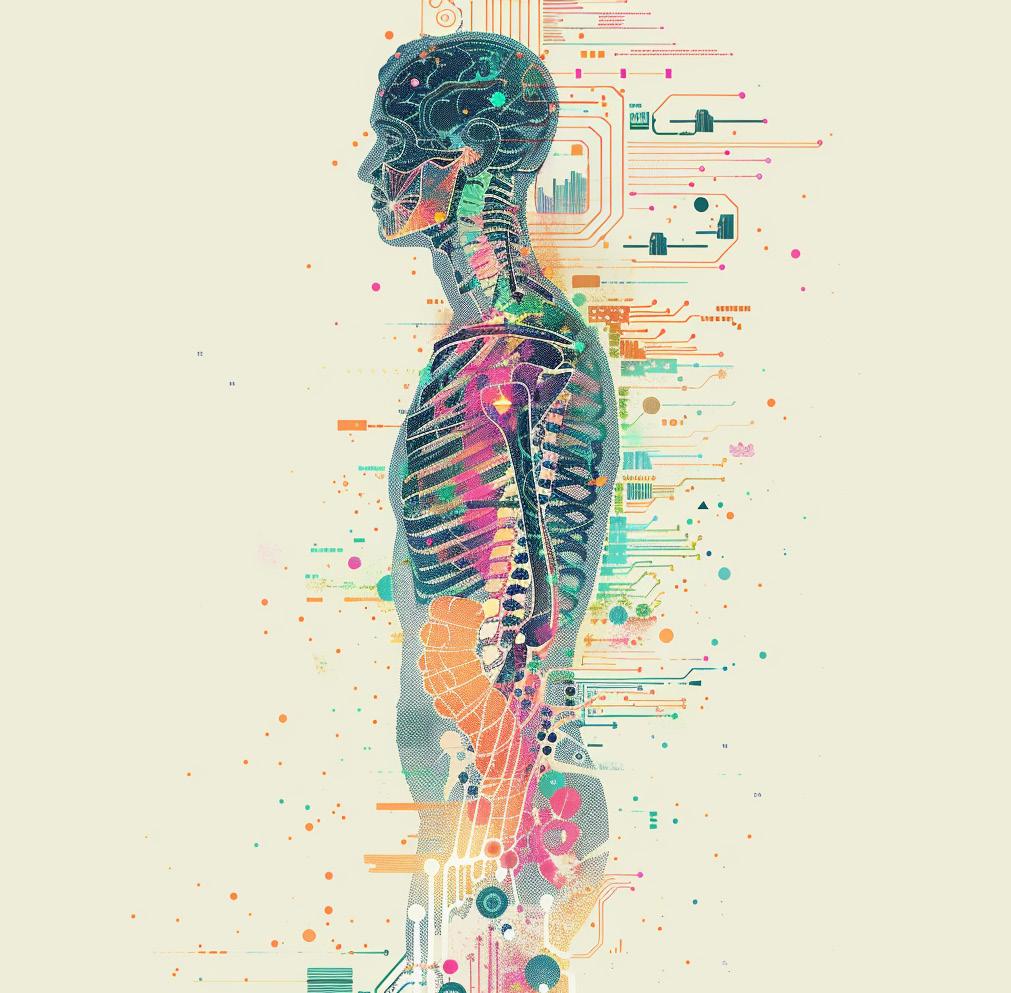
"Our bodies are not the next technological commodity."
won't be an anomaly, she'll be the norm.
All of this feels…overwhelming. The criminals, the indifferent corporations, the sheer complexity of the science. Do you honestly believe that the actions we've outlined – the regulations, the oversight – can actually win out against all that?
Let me be perfectly clear. This isn't about optimism, it's about necessity. The DNA black market, all the grim futures it opens up...these aren't inevitable. They're a choice we make every day we fail to act. Can we win? I don't know. But the alternative is far too monstrous to simply accept.
If there's one thing you want people reading this to take away, what would it be?
Our bodies are not the next technological commodity. Our genetic code isn't meant to be bought, sold, or manipulated in the shadows. This is a fight for what it means to be human in the 21st century. And it's a fight we can't afford to lose.
JENNIFER GONZALEZ is a senior writer at WIRED. She covers technology and health.
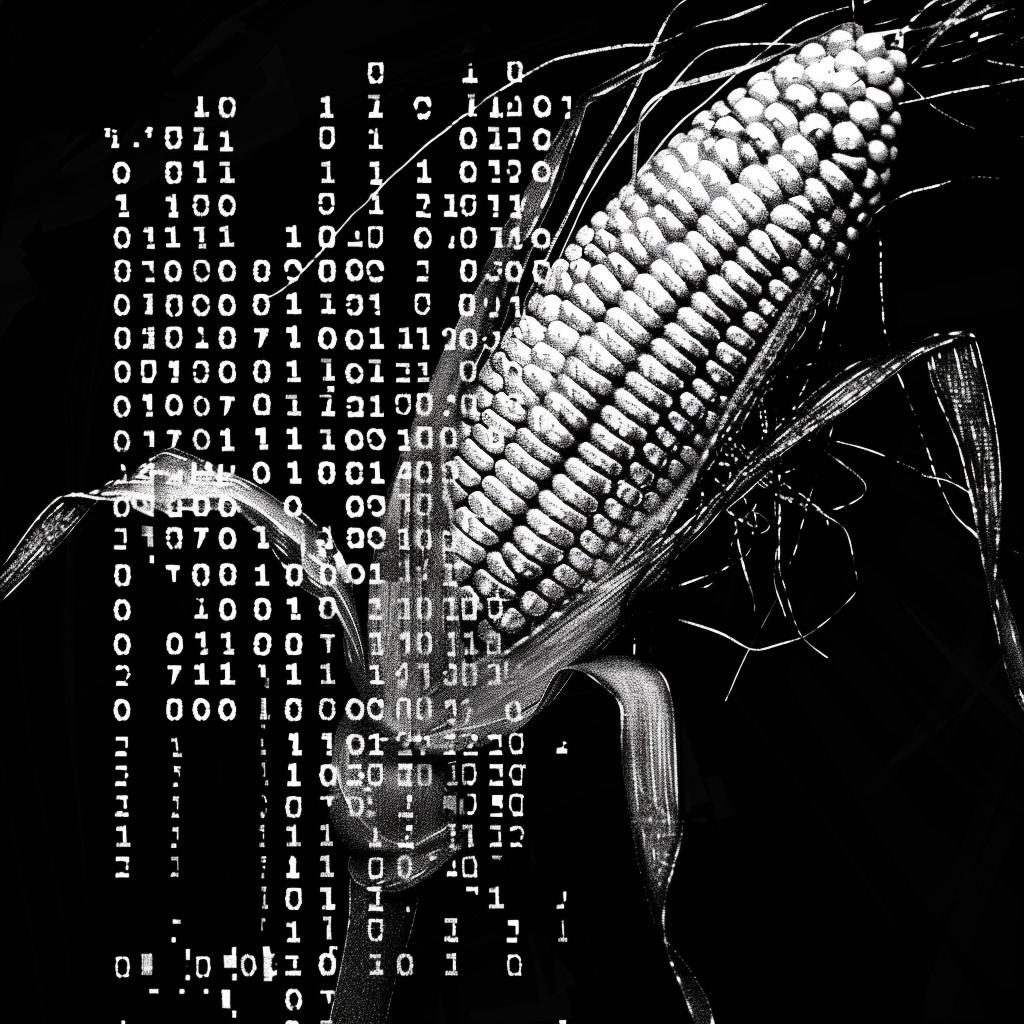
By Vincent Jensen

In the heart of Minnesota, a transformation is underway. Towns once synonymous with rolling fields and weathered barns are experiencing a renaissance fueled by a most unexpected source – DNA. The state has become a global hub for DNA data storage, and this technological shift has brought a surge of new opportunities and a revitalization of rural communities.
MMINNESOTA'S vast agricultural lands, once dedicated solely to traditional crops, now also cultivate data. Abandoned grain silos across the state have been repurposed into bio-synthesis centers, where rows of gleaming bioreactors hum with activity, crafting the DNA strands that store vast quantities of information. The infrastructure built to support agriculture – processing plants, transportation networks – has found a new purpose in the bio-data economy.
The heartland's iconic farmers haven't been left behind. Many have embraced this new form of agriculture. Their skills in precision processes and biological systems translate seamlessly to managing bioreactors and ensuring the quality of synthesized DNA. Labs have sprung up across the state specializing in error correction, contamination prevention, and the development of even denser DNA storage techniques. The University of Minnesota has become a powerhouse in bioinformatics and DNA data science, attracting top talent from around the world. Extension programs that once advised on crop rotation now offer courses on se-
quencing protocols and data encoding algorithms.
The DNA storage boom has breathed new life into Minnesota's small towns. High-skilled jobs in bio-synthesis, sequencing, and data analytics have drawn a younger generation back to their roots. Main Streets bustle with researchers, technicians, and entrepreneurs collaborating in sleek co-working spaces. Coffee shops buzz with discussions of gene editing and sustainable bioreactor design. This influx of talent and investment has revitalized communities. Schools boast cutting-edge STEM programs. Farm-to-table restaurants utilize locally cultivated produce alongside lab-grown delicacies made possible by DNA data storage. A vibrant arts scene is flourishing, inspired by the intersection of science and creativity.
Minnesota's transformation is a testament to the power of ingenuity and adaptability. The state's commitment to energy-efficient DNA storage practices and land-use policies ensures that this boomtown revival occurs in harmony with the natural environment. The "Bio-Boomtowns" of Minnesota offer a blueprint for the future. They demonstrate that it's possible to embrace cutting-edge technology while preserving the character of rural communities, and that progress can flourish alongside a deep respect for our agricultural heritage. As DNA storage reshapes the world's information landscape, Minnesota stands as a beacon, showcasing
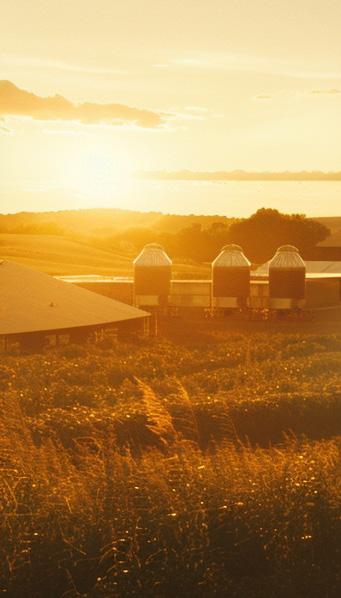
how technology and tradition can work hand-in-hand to build a brighter tomorrow.
Data farmers come from diverse backgrounds. Some are traditional farmers who have transitioned into data farming, building upon their knowledge of land management, biological processes, and precision technologies. They develop new skills in DNA synthesis, bioreactor management, and data quality assurance. Others are biotechnologists with backgrounds in molecular biology and genetics, finding new applications for their expertise in the field of data farming. They play crucial roles in optimizing synthesis processes, identifying potential contamination risks, and developing new error-correction methods for DNA storage. As datasets move into the biological realm, data scientists and bioinformaticians also have a niche to fill on the data farm. They develop algorithms to translate complex information into DNA code, manage vast biological databases, and analyze trends
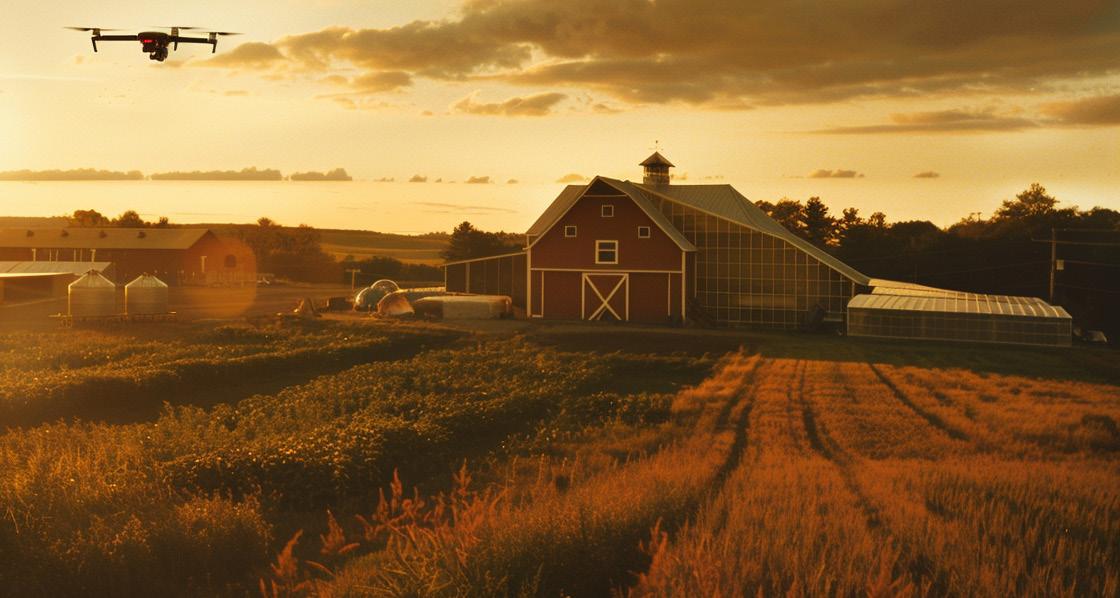
within stored data. Young people raised in rural Minnesota are excited by the potential to stay in their hometowns while working at the forefront of technology. They pursue hybrid degree programs in agriculture, data science, and bioengineering, becoming the future leaders of DNA-driven agriculture.
A day in the life of a data farmer is a unique blend of the familiar and the futuristic. Alongside traditional crops, data farmers might cultivate specialized strains of bacteria or algae optimized for rapid DNA synthesis. They monitor growth conditions, nutrient levels, and ensure biosecurity protocols are strictly followed. Data farmers also oversee bioreactors where strands of DNA are meticulously crafted based on digital blueprints. They track synthesis progress, adjust parameters for optimal efficiency, and work with bio-engineers to design the next generation of synthesis systems. Strict quality control protocols are crucial, so data farmers conduct regular DNA sequencing, utilize error-correction algorithms, and develop contamination prevention strat-

egies to ensure the longevity and accuracy of stored data. Additionally, data farmers champion sustainable practices. They integrate bioreactors with traditional agriculture, explore the use of renewable energy, and contribute to research on the long-term environmental impact of bio-based data storage.
Beyond their specific skills, data farmers embody the same pioneering spirit as their agricultural ancestors. They are resourceful problem-solvers, comfortable with both the complexities of biological systems and the power of data. They possess a deep respect for both the natural world and the groundbreaking technology they steward. The rise of data farming symbolizes a powerful convergence – a testament to the adaptability of the American heartland and the enduring power of working in harmony with nature to solve the challenges of the future.
The DNA storage boom has made the region an attractive destination for businesses seeking to align their operations with a commitment to environmental responsibility. This attraction led a major tech company to establish a groundbreaking "green" data center in partnership with local energy innovators and bio-synthesis specialists. The facility draws its energy from an extensive solar array established on land leased from local farmers, along with a dedicated wind farm. This renewable energy mix minimizes the center's carbon footprint and supports the region's broader shift toward sustainable power generation. Additionally, the "green" data center utilizes an innovative liquid cooling system. This captured heat is channeled into neighboring bioreactors, enhancing the growth of specialized algae strains used in DNA synthesis – a brilliant example of circular resource use. The data center's establishment involved close collaboration with the University of Minnesota. Together, they developed advanced energy monitoring software, optimizing power usage and further reducing the center's environmental impact. Students gain hands-on experience while the tech company benefits from cutting-edge research in the field of sustainable data center technologies. The success of the "green" data center has garnered attention within the tech industry. It demonstrates that environmentally responsible operation is not only feasible but can be a competitive advantage. This project has the potential to inspire a wider shift towards sustainable practices within the data storage sector.
Minnesota's transformation from agricultural heartland to DNA data hub sends a powerful message to rural communities across the globe. It proves that a decline in traditional industries
doesn't have to equal economic stagnation. With forward-thinking leadership and a willingness to adapt, new and unexpected opportunities can emerge.
The state's investment in innovative educational programs, from technical colleges to the flagship university, produced a skilled workforce ready to embrace the challenges of bio-based data storage. This highlights the importance of prioritizing lifelong learning and skill development for communities facing economic shifts. Moreover, the success was driven by the open collaboration between farmers, scientists, entrepreneurs, and policymakers. This created a fertile environment for shared knowledge, innovative problem-solving, and the rapid adaptation of existing skills to a new technological landscape. Finally, Minnesota's commitment to making DNA storage environmentally sustainable attracts ethically conscious businesses and talent. This focus on green technologies positions the state as a leader in the responsible development of cutting-edge industries.
While each community is unique, there are aspects of Minnesota's story that can be adapted and scaled. Communities can start by carefully assessing their resources – be it agricultural know-how, manufacturing expertise, or educational institutions. Identifying existing strengths is vital for finding creative synergies with emerging technologies. Fostering collaboration between local businesses, universities, and research centers can spark innovation. Minnesota can serve as a case study and a potential knowledge-sharing partner for other regions. Finally, creating spaces for small-scale pilot projects and supporting entrepreneurs with grant programs can encourage a culture of risk-taking and adaptability.
Minnesota's story challenges the perception that technological innovation is concentrated solely in urban areas. It showcases the potential for rural regions to become hubs for cutting-edge technologies while remaining rooted in their unique identity and respecting their environmental heritage. The DNA data boom in the heartland is a testament to the enduring power of ingenuity, collaboration, and the willingness to build a brighter future in harmony with the natural world.


Your mind is a powerhouse of ideas. Unlock its full potential with revolutionary mind-mapping technology. Visualize your thoughts, make connections you never saw before, and power groundbreaking solutions.



Discover the unexpected at the Museum of Reclaimed Wonders. Witness discarded items transformed into stunning art - sculptures from electronics, murals from plastic, even bioluminescent life from debris. See how past waste fuels the creativity shaping a sustainable future. Plan your visit today!
Think "MCW tickets" to book your visit instantly.

